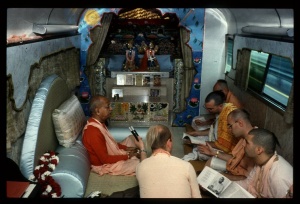CC Adi 10.107

A.C. Bhaktivedanta Swami Prabhupada
TEXT 107
- śrīnātha paṇḍita—prabhura kṛpāra bhājana
- yāṅra kṛṣṇa-sevā dekhi’ vaśa tri-bhuvana
SYNONYMS
śrīnātha paṇḍita — Śrīnātha Paṇḍita; prabhura — of the Lord; kṛpāra — of mercy; bhājana — receiver; yāṅra — whose; kṛṣṇa-sevā — worship of Lord Kṛṣṇa; dekhi’ — seeing; vaśa — subjugated; tri-bhuvana — all the three worlds.
TRANSLATION
Śrīnātha Paṇḍita, the forty-ninth branch, was the beloved recipient of all the mercy of Śrī Caitanya Mahāprabhu. Everyone in the three worlds was astonished to see how he worshiped Lord Kṛṣṇa.
PURPORT
Śrīla Bhaktisiddhānta Sarasvatī Ṭhākura writes in his Anubhāṣya, “About one and a half miles away from Kumārahaṭṭa, or Kāmarhaṭṭa, which is a few miles from Calcutta, is a village known as Kāṅcaḍāpāḍā, which was the home of Śrī Śivānanda Sena. There he constructed a temple of Śrī Gauragopāla. Śrīnātha Paṇḍita established another temple there with Śrī Rādhā-Kṛṣṇa mūrtis. The Deity of that temple is named Śrī Kṛṣṇa Rāya. The temple of Kṛṣṇa Rāya, which was constructed in the year 1708 Śakābda [A.D. 1786] by a prominent zamindar named Nimāi Mullik of Pāthuriyā-ghāṭa in Calcutta, is very large. There is a big courtyard in front of the temple, and there are residential quarters for visitors and good arrangements for cooking prasādam. The entire courtyard is surrounded by very high boundary walls, and the temple is almost as big as the Māheśa temple. Inscribed on a tablet are the names of Śrīnātha Paṇḍita and his father and grandfather and the date of construction of the temple. Śrīnātha Paṇḍita, one of the disciples of Advaita Prabhu, was the spiritual master of the third son of Śivānanda Sena, who was known as Paramānanda Kavi-karṇapūra. It is said that the Kṛṣṇa Rāya Deity was installed during the time of Kavi-karṇapūra. According to hearsay, Vīrabhadra Prabhu, the son of Nityānanda Prabhu, brought a big stone from Murśidābād from which three Deities were carved—namely, the Rādhāvallabha vigraha of Vallabhapura, the Śyāmasundara vigraha of Khaḍadaha and the Śrī Kṛṣṇa Rāya vigraha of Kāṅcaḍāpāḍā. The home of Śivānanda Sena was situated on the bank of the Ganges near an almost ruined temple. It is said that the same Nimāi Mullik of Calcutta saw this broken-down temple of Kṛṣṇa Rāya while he was going to Benares and thereafter constructed the present temple.”